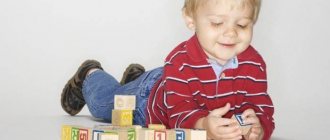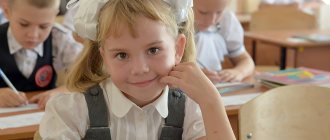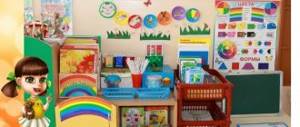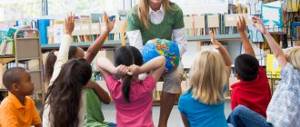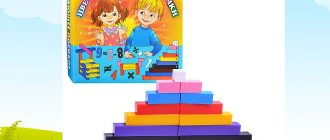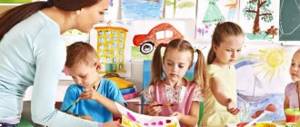Today, there is a large selection of different development methods and systems for preschool development and upbringing of a child. Many manuals have been developed with different methods for the early development of a child. Kindergartens operating according to the author's educational system are opening. Parents face a difficult task - how to choose the best one for their child from among all the methods? Is it possible to combine different methods for the development of your child? How can you apply this or that technique at home? So, developmental techniques for children.
The most popular methods of preschool education: N. Zaitseva; M. Montessori; B.P. and L.A. Nikitin. They are actively used by both parents, educators for preschool children, and teachers and psychologists for schoolchildren. These educational games are interesting for children. They are played in kindergartens, families and schools.
Zaitsev's technique
To ensure that your child’s preparation for school is more than successful, pay attention to the “Zaitsev’s Cubes” method. This method of teaching reading, the Russian language and more.
The author of the methodology is Nikolai Zaitsev, an innovator teacher from St. Petersburg, leader
Reading training
Developmental techniques for children. The classical principle of teaching reading using letters is complex, not natural, and develops speech complexes in children. The author has developed a basic principle for teaching reading to young children. Slad is a syllable, a combination of a consonant letter with a vowel, or a combination of a consonant letter with a soft or hard sign, or one letter. “Natural” warehouses, says the author of the method, Nikolai Zaitsev, are understandable to everyone from infancy. When the baby begins to speak, he pronounces these letter combinations or sounds. According to Zaitsev's method, these are warehouses.
“Cubes” by Nikolai Zaitsev is a set of cardboard cubes (52 pieces) with sound filling. The cubes differ in size and color.
Thus, the “Zaitsev’s cubes” method develops three zones of the child’s perception: auditory, visual and tactile. Warehouses are written on the walls of the cubes. For example, a cube: N-NA-NO-WELL-NY-NE. With the help of cubes you can lay out different words. This will allow a 3.5-4 year old child to learn to read. The author himself believes that the “Cubes” technique can be used for children from two years old.
How to practice using the Zaitsev method
Classes should be conducted in a playful way, because It is easier for a child to perceive material through play.
- For classes, you need to buy or make your own teaching materials based on a sample (Zaitsev’s cubes, tables), without which the process described in the author’s methodology is not possible.
- The application of the technique is based on the individual pace of each child, so rushing is not welcome here.
Methodology “Zaitsev’s Cubes” Video:
Books. Zaitsev's technique
The Zaitsev Methodology Society publishes various manuals by the author:
- "Zaitsev's Cubes" For practicing at home, you can make them yourself ().
- “240 pictures for teaching writing, reading, drawing.” An exciting game that contains a set of cards for activities. Quickly increases the child's vocabulary. Teaches you to read whole words.
- "Thousand +" () - teaching mathematics.
- “Who lives around me, what grows around me.” A study guide with flashcards for children learning to read.
- "Songs and nursery rhymes." Attached is a CD with songs.
- "Pure twisters and tongue twisters." Teaches you to speak correctly.
- Zaitsev N. A., Struve G. A. “Read and Sing” - funny and unpretentious nursery rhymes for classes.
- Zaitsev N.A. "Letter. Reading. Check" ()
- Afanasova E.G. “The Game Library of Writing and Reading by N.A. Zaitsev”, the methods of games and activities are popularly described here. ()
- Sing-along songs by the author himself. ()
Research methods in preschool pedagogy
Basic research methods in preschool pedagogy:
Observation. A method of targeted research of a pedagogical phenomenon or process. The researcher observes individual aspects of a phenomenon or evaluates it as a whole. The main task of the study is the accumulation and recording of facts and their essential aspects. Observation can be open, indirect (through other persons), hidden, intermittent or continuous, monographic, highly specialized. Requirements for conducting observation: purpose, objectives, planning, systematicity, programs, accurate recording, methods and techniques of observation. Observation requires accurate and objective recording of facts (filming, photography, diary entries, protocols, etc.) and processing of the results.
Finished works on a similar topic
- Course work Methods of pedagogical research in preschool pedagogy 470 rub.
- Abstract Methods of pedagogical research in preschool pedagogy 220 rub.
- Test work Methods of pedagogical research in preschool pedagogy 220 rub.
Receive completed work or specialist advice on your educational project Find out the cost
Experiment. Study of processes and phenomena in order to substantiate and test a scientific hypothesis. It can be natural, ascertaining (studying the state of the pedagogical process or phenomenon), laboratory (specially created controlled conditions), control (substantiation of the results and conclusions obtained) and formative (testing of the put forward hypothesis). An experiment requires organization of the researcher's behavior, technical preparation, taking into account instructions and conditions affecting the result, and recording the results. The purpose of the experiment is to determine patterns and connections between individual pedagogical processes, phenomena and their results in search of the best way to manage the pedagogical process.
Survey methods. Includes interviewing, conversation, testing, questioning.
Sociometry . Displays relationships in a team, interpersonal relationships, based on methods of observation or questioning of the established behavior of children. The method allows you to determine the role, place, status of the subject, and determine the stages of formation of relationships within the team.
Too lazy to read?
Ask a question to the experts and get an answer within 15 minutes!
Ask a Question
Study of pedagogical documentation and products of children's activities (protocols, reports, lesson notes, plans, products of manual labor and visual activities of preschoolers). The method allows you to obtain diverse information about the object under study, identify new facts and establish relationships between the processes and phenomena being studied.
Monographic study of children (in a group, individual child).
Method of studying and generalizing experience. Pedagogical experience is the practice of teaching and upbringing, which reflects the level of development of pedagogical science.
Mathematical method . It consists of mathematical processing of data and results that were obtained during the study process and displayed in charts, graphs, and tables.
A conversation is direct communication with a child or children using pre-thought-out questions. It involves the establishment of two-way contact, during which the ideas and interests of children, their feelings, attitudes, positions and assessments are revealed. Requirements for the method: presence of a plan (posing a question, complete surveys, mass participation, pedagogical tact), programs, focus.
Questioning . It can be conducted in the form of an interview (open) or closed (anonymous). Requirements for the survey – recording and systematization.
Interviewing in preschool pedagogy is used less often than other methods. The method is a one-way conversation, during which the initiator asks questions and the interviewee answers. The method requires careful development of the structure of the questionnaire and the creation of conditions that encourage children to be sincere.
Testing is a method of targeted examination, which is carried out using well-developed standardized questions, and allows one to objectively identify individual differences in children.
Note 2
Pedagogical research methods must be used in combination, taking into account the age characteristics of preschoolers.
Montessori development method
Developmental techniques for children. A child’s school preparation program can also be developed in accordance with the methodology (development system) of Maria Montessori. Much attention in this technique is paid to the development of the child’s feelings, sensations and fine motor skills.
The author of the method, Maria Montessori, is an Italian teacher, scientist, psychologist, doctor, who worked with “special” children.
At that time, “special” children were not treated or educated, but were simply isolated from society. M. Montessori has developed a special set of exercises and educational games to develop fine motor skills of fingers for children who speak poorly. Thanks to this, her students showed amazing results in their development.
Principles of the M. Montessori method
The motto of M. Montessori’s work was: help the child do everything on his own
- Yes, yes, on your own! Not for him, not with him, but independently. Only independent action moves the child’s development one step forward and creates interest. The formation of interest is the first principle of the Montessori method.
- Consider sensitive periods of child development . In their early development, children experience several sensitive (developmentally sensitive) periods of perception of the world around them. They do not recur in adulthood. In early childhood, a certain part of the brain develops. Therefore, it is very important to create a developmental environment around the child that will stimulate the development of those skills and abilities. It is necessary to carefully monitor the opportunities that arise in children. They manifest themselves at different times for everyone. But if they are not noticed in time, the child will lose interest in this for life. The second principle of the Montessori method is an individual approach.
- Development of mental abilities through the development of fine motor skills in the fingers and toes . At the child’s fingertips there are nerve endings that need to be stimulated for better development of brain processes. The games and exercises developed by M. Montessori for the development of a child’s sensory sensations formed the basis of her developmental methodology or even the Montessori education system.
- All Montessori playbooks are very easy to make from what you have on hand!
Montessori method. Video
Maria Montessori. Books
- Maria Montessori . My method. This is the first publication in Russian of the fundamental work of the unique Italian teacher, psychologist and doctor Maria Montessori. The author’s ideas about the free self-development of a child in a specially equipped developmental environment remain relevant 100 years later.
- Maria Montessori. Early development methodology From 6 months to 6 years This book describes in detail ways to create a developing environment for a child, exercises that not only teach, but also delight.
Preschool teaching methods
- Waldorf pedagogy is aimed at the spiritual development of a free personality, while teaching basic knowledge in the form of reading and writing is not paid attention;
- Maria Montessori's approach, the formation of an independent personality with an internal desire for knowledge;
- The pedagogical approach of Cecile Lupan, the development of the individual according to her needs, when the parent helps to master what the child has shown interest in;
- Game approach of Boris and Elena Nikitin. Development of mental and physical abilities without taking into account the development of creative potential;
- Glen Doman and his cards. Development of encyclopedic knowledge;
- Nikolai Zaitsev's approach, early teaching of a child to read and count;
- A traditional method of education adopted at the state level for educating children in preschool educational institutions. Can be used by parents for home schooling based on methodological recommendations for preschool teachers.
This is just a small list of popular methods that are supported by millions of parents. The difference in approaches to the same things from different methods allows parents to choose the course of action that seems most suitable to them.
Some people think that it is not worth teaching a child to read at 2 years old, but rather teach him music; others will decide that drawing and modeling are more important than physical activity. Unfortunately, there are no ideal approaches, just as there are no identical children. Just when choosing a technique, remember that your child is unique and determine what is more important to you.
In order to choose the right method for teaching children, it is worth understanding the pros and cons, advantages and disadvantages of each of them.
Waldorf pedagogy or Steiner method
This technique, developed by the Austrian Rudolf Steiner at the beginning of the twentieth century, focuses on the emotional development of the child, in particular on the spiritual, biological and social development of the individual. Aimed at the independence of the individual from social restrictions, it assumes that a child studying using this method will feel at home anywhere in the world.
Waldorf school teachers must provide support in unlocking inner potential, so that already in preschool age the child can sufficiently develop those qualities that will become the basis of a mature personality. The child should be in the fairytale-like world of his fantasies for as long as possible and strive to know himself and his talents. Proponents of this theory attribute teaching complex types of knowledge - writing and reading - to the period when the child matures spiritually and a period change occurs on his biological clock. The change period takes place after the complete replacement of milk teeth with molars (12 years).
Basic principles:
- Respect for the child and his personality. Psychological comfort comes first;
- The basis for personal development lies in the development of aesthetic and labor skills, through which creative abilities are revealed;
- Particular attention is paid to the study and penetration of the values of the national culture, which allows the child to feel part of something larger than his family;
- The study of the external environment occurs through an integrated approach. The child should be closer to nature. All objects around should be made of natural materials and simple shapes;
- Training takes place in separate blocks, which are evenly divided throughout the day. The child learns the labor, creative and mental-spiritual components of human life. By dividing all educational material into “epochs”, which last approximately one month, conscious memorization of all necessary knowledge takes place.
The advantages of this method include the following points:
- If a child has a strong humanitarian mindset, then this school is ideal for him, because... Only this technique devotes such a large amount of time to the development of creative potential;
- The absence of an evaluation system allows the child not to be afraid of mistakes, which makes the process harmonious;
- Using a wide variety of playing materials and forms of natural materials made from them.
Minuses:
- This system is not suitable for children with pronounced mathematical abilities, because will not meet their internal needs;
- Lack of reading and writing instruction in the preschool period does not help prepare a child for school;
- Lack of all forms of media. Children are prohibited from television, radio and cinema.
Pros and cons of the Waldorf school
Maria Montessori's approach
The method of Maria Montessori, based on the belief that a child needs to be raised and trained as a free individual capable of independently acquiring the necessary skills and knowledge, is considered quite popular today.
The founder of this technique noticed that children by nature want to learn and absorb all the features of their culture and civilization without fatigue. By freeing the child and rewarding him with the freedom to explore, the baby will be eager to learn. Through self-motivation and self-knowledge established at an early age, lifelong learning will occur.
For this technique, special didactic material was developed, which, based on sensory, allows you to teach children.
It is interesting that the creator of this technique was of the opinion that toys should be called “material”, and playing with a child “activities”.
Training includes some physical exercises, activities to develop fine motor skills and speech. The child is also offered classical types of activities in the form of design and modeling, appliqué and drawing. Musical forms and educational games included.
Maria Montessori suggested starting classes with children using this method from 2.5 years old.
Today, classes using minor modifications begin at 8 months of age. This approach is often condemned by adherents of the classical model, since at this age there are few opportunities to provide the child with an independent choice of activities without the direct participation of an adult.
Basic principles:
- Non-intervention of an adult;
- Help me do it myself;
- Freedom to choose an activity;
- Get interested, and the child will develop on his own.
This method, aimed at developing independence and self-discipline on the part of the child, has many supporters and opponents, but with a seemingly controversial attitude, it has its undeniable advantages and disadvantages
Pros:
- The development of observation, discipline and independence as an important criterion for the development of a future personality;
- Development of fine motor skills;
- The positive impact of this technique on the development of logic and analytics. Independent search, stimulating the work of the child’s brain, develops qualities important for school learning and later life;
Minuses:
- The system teaches only intellectual and practical skills and does not develop creative skills;
- Lack of role-playing and outdoor games;
- Learning in such a free environment can be a challenge when adapting to school rules.
Pedagogical approach Cecile Lupan
Early development methodology, which is aimed at establishing a close connection between the adult involved in education and training and the child. It is this connection that allows the parent to notice and understand the child’s cognitive desire in time.
Based on the fact that the founder of the method believes that a child is not a vessel that needs to be filled, but a fire that needs to be kindled, the method is not aimed at teaching the child the necessary skills and knowledge, in the opinion of the parent, but at helping in learning what interests the child .
The idea is that the child himself can show what he wants to do at the moment, and it is the parent’s responsibility to see and understand the child’s desire. The technique implies that if a child is interested in any subject, then it is worth occupying his attention with broad coverage of the subject of interest. So, for example, if he points to a scarf, then allow him to develop sensory skills by giving samples of different materials.
The Cecile Lupan method is characterized by a large number of different subjects that are taught to the child. Disciplines such as geography, history, music, etc. are given to the child in accordance with his wishes, not always in the amount usual for this age.
An interesting technology used in this technique is teaching a child using individual books in which he himself is the hero. Also, the training program using this method necessarily includes learning to swim from a very early age.
Basic principles of this technique:
- Consider the child’s desire and provide him with subjects to study;
- Parents are their child's primary teachers;
- Classes should be stopped before the child starts to get tired. Both parents and children should feel joy from the activity. The child needs to be interested in, not patronized;
- The child does not need to be tested;
- Maintaining interest and developing curiosity through novelty of material and speed of presentation.
Following these principles, the methodology assumes that each parent who has chosen this approach should take from the huge amount of material offered only that which is directly suitable for his child. An important aspect in this technique is the manifestation of love and tactile contact between the child and the parent in the process of cognition.
Pros:
- Comprehensive training of the child in the skills that interest him at the moment and to the extent that he can learn;
- No compulsion to learn. Through offering a game or activity, choosing the one that interests the child at the moment.
- Creating a warm and trusting relationship between child and parent.
Minuses:
- Strong recommendations for early learning to swim;
- A large amount of information offered for teaching a child if parents make a mistake can lead to overload and denial of new knowledge in the child;
- There are no fundamentals for socializing a child and accustoming him to a group of children.
Game approach of Boris and Elena Nikitin
The technique, developed from the experience of the Nikitins, who raised seven children, often causes controversy and conflicting reviews, but it is quite popular due to its innovative approach.
The married couple believes that in the modern world all methods are divided into two camps. In one, there are techniques that create the effect of a child being very busy and organized, in which the latter does not have time for independent study. In the second camp there are methods that, at their core, contain only the child’s freedom of action, without accustoming him to classes according to certain criteria, which causes problems in further schooling.
The Nikitins have created their own approach, which, in their opinion, allows them to combine the characteristics of both types of training.
The Nikitins' technique consists of developmental and physical tasks that become more complex as they are mastered. Freedom of creativity and activity time is at the core, with adults nearby to help solve problems rather than interfere or force. If for some reason a child cannot solve a certain problem, then it should be postponed until an adult period.
Great attention is paid to physical development. Hardening and exercises are introduced from the moment the baby is born. Important for the application of this approach is the presence of a sports corner in the house to perceive physical activity as an obligatory part of life.
This methodology is based on the following principles:
- Closeness to nature and creativity, work and naturalness. Growing up in a sporty environment, wearing loose, comfortable clothes, close to nature;
- No coercion from parents. Freedom of creativity and freedom to choose an activity;
- Push in development, but do not get ahead. The parent should be not indifferent to the child’s success even in the simplest tasks;
- Maximize the creative side of a child’s life and prepare him for growing up;
Pros:
- Possibility of mastering by any parent and ease of application in practice;
- Attention not only to the development of mental, but also physical abilities;
- The approach allows you to master the rational organization of time for children and adults.
Minuses:
- All children study according to a single program, and there is no individual approach;
- There is practically no material for speech development, and creativity is excluded from the methodology in principle.
- A tough approach to hardening.
Glen Doman and his cards
Doman cards
Glen Doman's teaching method is designed to teach children from a very early age and claims that the greatest effect can be obtained by developing the cognitive abilities of children from birth. The method is based on special cards, which are named after the creator. Doman cards are small pieces of paper with a picture and words written in large letters.
The technique is designed for children’s ability to absorb a large amount of information that will be presented through a special system. With a reasonable approach, the technique allows you to develop an inquisitive mind, stimulates the early development of speech and creates the basis for further speed reading. Harmoniously combined intellectual and physical activity makes it possible to develop cognitive abilities to a high level by the age of 6-7 years, when, according to the author of the methodology, the main learning process begins. This method also includes a set of physical exercises that should develop the child from birth, stimulating cognitive abilities.
Taking as a basis the assumption that the child’s desire for knowledge is due to the need for survival, and the absence of fatigue in childhood when comprehending new things.
The Doman technique is based on the following principles:
- Physical activity is the foundation for the development of the intellect and body;
- The child must learn to read at the same time as he learns to speak;
- Mathematics is the basis for future intelligence, and learning should come from learning a real number, not a number;
- Cultivating encyclopedic knowledge from all possible areas of human life from a very early age.
Pros:
- Children develop a large base of information;
- Visual memory and physical abilities are trained;
- Correct application of the technique helps parents and children spend a lot of time together, which has a beneficial effect on the child’s development.
Minuses:
- Learning to read according to Doman involves memorizing the entire word; there is no teaching of letters and sounds;
- The technique provides a large amount of information, but does not develop the ability to use it.
Methodology of Nikolai Zaitsev
One of the most popular methods in post-Soviet countries, created by innovative teacher Nikolai Zaitsev. A peculiarity of the method of education and training, which is based on teaching reading and speaking using a system of cubes. Unlike classic cubes, not letters are drawn on the sides, but syllables. The choice of teaching reading through the use of syllables is explained by the creator of this technique.
Nikolai Zaitsev claims that a child learns to speak not in individual letters, but in syllables. This feature confirms the fact that the smallest unit of a word for a child will not be a letter, but a syllable. Based on this, in order to easily memorize and understand the reading system, a child needs to be taught syllables. The cubes also vary in size, color and filling. They allow you to teach not only reading, but also the basics of phonetic hearing.
This technique is recommended to be used at an early age, even when the child has not yet learned to speak. This method also includes learning to count. It is proposed to teach a child number series, using technology similar to teaching reading.
The learning process itself takes place in a playful way. To memorize and practically apply this technique, children are offered a variety of options for pronunciating syllables. Clap your hands, sing, bring the required cube. With the help of various motor techniques, not only the rules of word composition are memorized and understood, but the child’s physical skills are also developed, which allows him to maintain health. Also, active play with teaching material allows you to maintain interest in the learning process longer. The technique is suitable for both group and individual study.
Principles:
- No pressure on the child from an adult, presenting the material in a playful way;
- Achieving a goal using basic material, which is the basis of the learning process.
- An individual approach to each child, allowing each individual student to be given the opportunity to fully assimilate the material.
Zaitsev’s methodology, today, is being actively implemented in kindergartens and clubs and may soon become part of the traditional teaching methodology.
Pros:
- Early learning to read and count, through the development of visual memory and memorization abilities;
- Development of creative thinking, through understanding the process of word creation;
- The versatility of the method allows it to be used both for individual training and in groups.
Minuses:
- Due to the use of large teaching aids (cubes), insufficient time is devoted to the development of fine motor skills.
- The methodology is aimed at mastering reading and counting, but does not take into account the needs for knowledge of other disciplines.
Traditional methods of pedagogical training for preschoolers
The traditional method is the approach that is usually used in preschool educational institutions and corresponds to a state-recognized program and standards recognized for children of the appropriate age.
The methodology is based on the fact that all classes are conducted in groups using games. It is prohibited to use any activities that would have some kind of reminder of how classes are conducted at school. The grading and certification system is not applied to children. At the same time, all children in the group are classified according to basic personality traits.
Three basic approaches are used in training. So each lesson should be visual, verbal or practical, or combine all three methods. Also, when using these approaches, the ability to teach a group of children with the highest degree of involvement of everyone in the learning process plays an important role.
According to the established standards for the traditional method of raising and developing a child under 7 years of age, the following skills are the guideline:
- Development of initiative in a child as an important skill for successful learning;
- Independence training;
- Development of self-confidence;
- Self-acceptance and general positive attitude towards people;
- Development of fantasy and imagination;
- Unlocking creative abilities;
- Development of fine motor skills;
- Discovering and strengthening willpower to achieve your goals;
- Interest in learning new things;
It can also be noted that the traditional method of teaching a child, which is used in preschool educational institutions, is based on the desire to teach and consolidate the knowledge that the child will need during further schooling. But at the same time, the traditional method of acquiring knowledge does not include some popular approaches and activities that may be considered mandatory by many parents in the preschool period.
The disadvantages of the traditional government approach to educating children include the following:
- Almost complete absence of an individual approach to students; For example, training in a preschool educational institution to work with objects that meet the child’s creative impulses is carried out only in the presence of a teacher in a group. Outside of class, the child does not have the opportunity to individually study the subject of interest to him, since they are out of his reach.
- The dominant role of the teacher in the learning process. The child gains knowledge within the group and, being in the role of a passive student, can only follow the path that the teacher offers him;
- Developmental activities in most cases follow the path of explanation, and not the path of creative search.
- Training follows a strict schedule and schedule, which is not disrupted in the absence of one child.
Nikitin's technique
Developmental techniques for children. The main motto of the Nikitins’ methodology: development should be creative and free. Developmental activities must be alternated: intellectual, creative, sports. The sports atmosphere plays a major developmental role, therefore, all conditions for playing sports must be created in the house.
Nikitin's education system
- Freedom of creativity. There is no need to organize special classes. The child can study as much as he wants.
- A sporty atmosphere in the house and light clothing. You should have sports equipment at home from childhood. Children should not be bundled up; they should be hardened from infancy.
- Never do for a child what he can do himself. Conditions for a child’s development must be created taking into account his wishes, without focusing on his own interests.
- Creating conditions that advance the development of the child. Create developmental conditions at home before the child can use them.
- The principle of NUWERS is the irreversible extinction of opportunities for effective development of abilities. For each child there is a certain time for the development of specific abilities; if they are not developed in time, they will be lost forever.
Nikitin's technique: video
Nikitin's technique. Books
- B.P. Nikitin. Childhood without illnesses.
- L.A. Nikitina. I'm learning to be a mom
- L.A. and B.P. Nikitina. We, our children and grandchildren
- B.P. Nikitin. A capable child is not a gift of nature. Hypothesis of the emergence and development of creative abilities
- L.A. Nikitina. Zh.S. Sokolova, L.A. Bludova. Parents of the 21st century
- B.P. Nikitin. Mind games
Persuasion technique
This technique is focused on conducting conversations with a child, during which they try to convince him of the correctness or incorrectness of certain actions or actions. The dialogue should be structured in such a way that the child understands its essence and significance. The teacher’s speech should be logical and simple for the child to understand. Also, the teacher must see feedback, i.e. the conversation must be a real dialogue in which the child takes part, and not just a monologue of a parent or teacher, difficult for the child to perceive.
Note 2
Using the persuasion technique, one should focus on the individual properties of the child’s personality, his perception and development of thinking.
Lettergram. Developmental methodology
Author: candidate of psychological sciences, neuropsychologist Svetlana Yulianovna Shishkova.
Developmental techniques for children. Program S.Yu. Shishkova develops the child’s phonemic hearing and forms spatial awareness. The tasks presented in the video game, in the book, and in the extended program on disk are aimed at developing fine and gross motor skills. To prepare your child for school, games are included to develop the child’s speech and math skills. This technique is designed to prepare children for schooling from the age of 4 years. The main principle: combining sensory and motor components during the child’s learning period. To carry it out at home, this is a fairly simple technique. Following her instructions, classes can be conducted by parents themselves. Of course, for this you need to study the entire methodological complex. With a simple approach, the effect of the program is unexpectedly effective.
About the Bukvogram method:
- You can practice at home or in any other place convenient for you.
- For training you will need a computer or laptop with a disk drive (required to install and use the application). You can study from a book.
- For learning, a child will only need writing utensils and a place to write - a notebook or notepad.
- The time of one lesson is 30 minutes.
- The complex contains only exercises and educational games that are interesting for children.
- The lesson can be conducted by the child’s parents, teachers or psychologist.
- For educational and developmental results, the Bukvogram method requires strict completion of all classes in the sequence suggested by the author.
- For the best effect, daily lessons are needed so that the child does not have time to forget the material.
- The author of the method recommends repeating the exercises within a lesson from 2 to 5 times.
- One lesson may take from 1 to 5 days.
Lettergram. Video
How to choose the right method?
Each method, while having its own advantages, also has its own disadvantages, which can become critical for many parents. The choice of one or another technique and approach depends on the individual views of parents on the process of education and upbringing.
To select the appropriate method, you need to do the following:
- Decide what this methodology should emphasize in teaching a child (knowledge, creativity, spiritual development)?
- Explore how the learning process works and is it suitable for you and your child?
- What are the pros and cons of the chosen technique?
- When choosing more than one technique, it is necessary to evaluate how well they are combined with each other.
Criteria for choosing a technique
To choose a method of teaching a child, parents must answer the question of what they want to get from preschool education:
- General knowledge;
- Unlocking the child’s creative potential;
- Form a free personality;
- Develop physical skills;
- Gain encyclopedic knowledge;
- Something other.
Most often, one technique is aimed at developing one or more of these criteria. Today there is no one approach that would fully ensure the equal development of all these areas. As a result, parents need to either adopt one of the most suitable methods or combine several in the desired proportions. Remember that the ability to combine and take the most necessary things from methods allows parents to successfully resolve most issues related to the education of a child under 7 years old.
